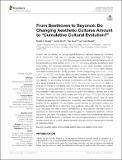Files in this item
From Beethoven to Beyoncé : do changing aesthetic cultures amount to ‘cumulative cultural evolution’?
Item metadata
| dc.contributor.author | Sinclair, Natalie C. | |
| dc.contributor.author | Ursell, James | |
| dc.contributor.author | South, Alex | |
| dc.contributor.author | Rendell, Luke | |
| dc.date.accessioned | 2022-02-09T15:30:04Z | |
| dc.date.available | 2022-02-09T15:30:04Z | |
| dc.date.issued | 2022-02-09 | |
| dc.identifier | 277357411 | |
| dc.identifier | e0786920-5beb-4733-9d67-73bacec74b11 | |
| dc.identifier | 000761041100001 | |
| dc.identifier | 85125325703 | |
| dc.identifier.citation | Sinclair , N C , Ursell , J , South , A & Rendell , L 2022 , ' From Beethoven to Beyoncé : do changing aesthetic cultures amount to ‘cumulative cultural evolution’? ' , Frontiers in Psychology , vol. 12 , 663397 . https://doi.org/10.3389/fpsyg.2021.663397 | en |
| dc.identifier.issn | 1664-1078 | |
| dc.identifier.uri | https://hdl.handle.net/10023/24836 | |
| dc.description | Funding: NS was funded by a Carnegie Ph.D. Scholarship. | en |
| dc.description.abstract | Culture can be defined as “group typical behaviour patterns shared by members of a community that rely on socially learned and transmitted information” (Laland and Hoppitt, 2003: p. 151). Once thought to be a distinguishing characteristic of humans relative to other animals (Dean et al., 2014) it is now generally accepted to exist more widely, with especially abundant evidence in nonhuman primates, cetaceans and birds (Aplin, 2019; Rendell and Whitehead, 2001; Whiten, 2021). More recently, cumulative cultural evolution (CCE) has taken on this distinguishing role (Henrich, 2015; Laland, 2018). CCE, it is argued, allows humans, uniquely, to ratchet up the complexity or efficiency of cultural traits over time. This ‘ratchet effect’ (Tomasello, 1994) gives the capacity to accumulate beneficial modifications over time beyond the capacities of a single individual (Sasaki & Biro, 2017). Mesoudi and Thornton (2018) define a core set of criteria for identifying CCE in humans and nonhuman animals that places emphasis on some performance measure of traits increasing over time. They suggest this emphasis is also pertinent to cultural products in the aesthetic domain, but is this the case? Music, art and dance evolve over time (Savage, 2019), but can we say they gain beneficial modifications that increase their aesthetic value? Here we bring together perspectives from philosophy, musicology and biology to build a conceptual analysis of this question. We summarise current thinking on cumulative culture and aesthetics across fields to determine how aesthetic culture fits into the concept of CCE. We argue that this concept is problematic to reconcile with dominant views of aesthetics in philosophical analysis and struggles to characterise aesthetic cultures that evolve over time. We suggest that a tension arises from fundamental differences between cultural evolution in aesthetic and technological domains. Furthermore, this tension contributes to current debates between reconstructive and preservative theories of cultural evolution. | |
| dc.format.extent | 15 | |
| dc.format.extent | 1139655 | |
| dc.language.iso | eng | |
| dc.relation.ispartof | Frontiers in Psychology | en |
| dc.subject | Cumulative culture | en |
| dc.subject | Cultural Evolution | en |
| dc.subject | Aesthetic value | en |
| dc.subject | Music evolution | en |
| dc.subject | Animal cultures | en |
| dc.subject | BF Psychology | en |
| dc.subject | QH301 Biology | en |
| dc.subject | T-NDAS | en |
| dc.subject | MCC | en |
| dc.subject.lcc | BF | en |
| dc.subject.lcc | QH301 | en |
| dc.title | From Beethoven to Beyoncé : do changing aesthetic cultures amount to ‘cumulative cultural evolution’? | en |
| dc.type | Journal item | en |
| dc.contributor.institution | University of St Andrews. Sea Mammal Research Unit | en |
| dc.contributor.institution | University of St Andrews. School of Biology | en |
| dc.contributor.institution | University of St Andrews. University of St Andrews | en |
| dc.contributor.institution | University of St Andrews. Centre for Social Learning & Cognitive Evolution | en |
| dc.contributor.institution | University of St Andrews. Centre for Biological Diversity | en |
| dc.contributor.institution | University of St Andrews. Marine Alliance for Science & Technology Scotland | en |
| dc.contributor.institution | University of St Andrews. Bioacoustics group | en |
| dc.identifier.doi | 10.3389/fpsyg.2021.663397 | |
| dc.description.status | Peer reviewed | en |
This item appears in the following Collection(s)
Items in the St Andrews Research Repository are protected by copyright, with all rights reserved, unless otherwise indicated.

